Our 18Stripes colleagues do a fantastic job breaking down football film, so we figured we’d take a shot at explaining a few of the more interesting lacrosse plays fans will witness this season. We will call these segments Lacrosse Playbook since all the other good names were taken.
Joe Keegan (twitter: @joekeegs) wrote a fantastic piece on CollegeCrosse.com about the impact of Pierre Byrne’s dodging on the 2017 Notre Dame Lacrosse offense. It’s an excellent read that we recommend highly. It outlines the various ways Byrne can initiate offense in the current Notre Dame setup.
One clip of the Michigan game that Keegan utilized in his piece illustrates well how good the Irish offense can be when everyone in on the same page. It’s a play that stood out to us even in our first watching of the game because of how precise the off-ball movement seemed in real-time. Basketball types may enjoy this as well, since many of the principles involved are similar to what you want to see in hoops.
The play itself results in goal by Pierre Byrne after he dodges around the back of the goal. A great play by Byrne on its own merits, but the role of the other five on the field is equally as fascinating:
Let’s break it down.
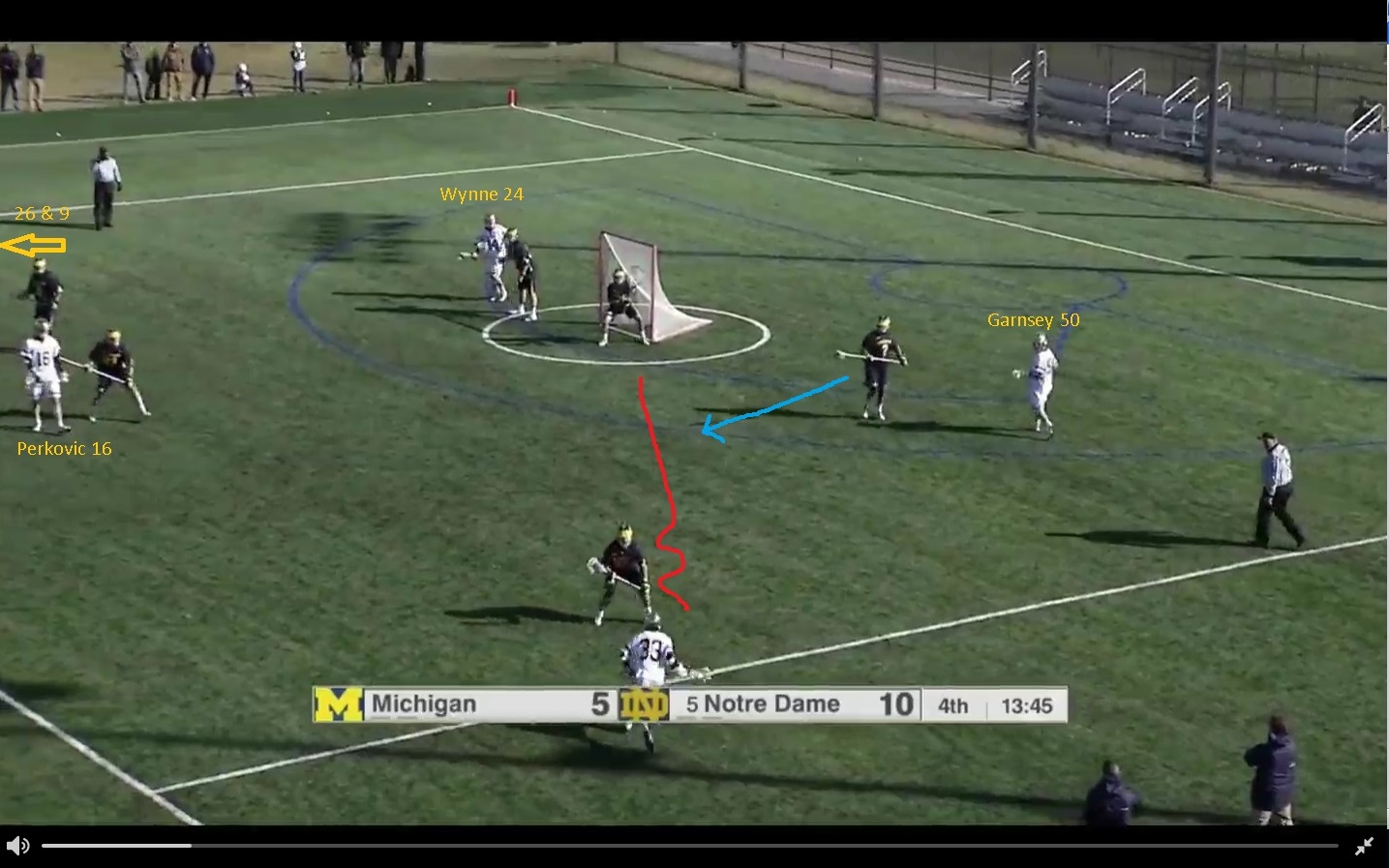
STARTING EVALUATION:
#33 Pierre Byrne has the ball and is covered by a short-stick defenseman. He theoretically should be able to beat his man without too much trouble along the red line. However, this will leave him a relatively low-angle shot as he is a dominant righty. Plus, the defender covering Garnsey is in position to slide and shut down Byrne’s dodge (blue arrow). Wynne is in his usual spot on the crease and Perkovic is occupying a defender up top. Costabile and Gleason are way up high and off screen.
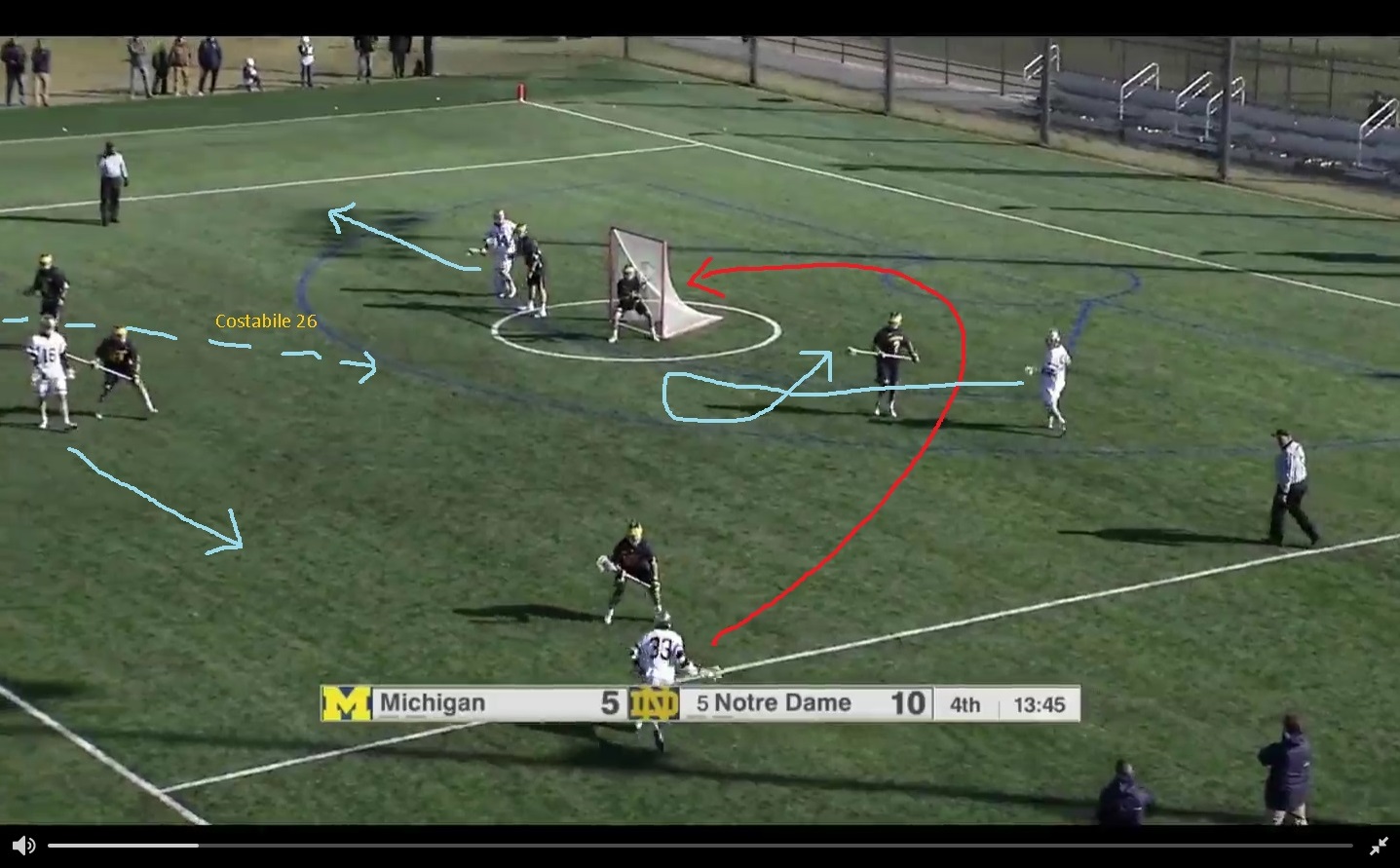
PLAY INITIATED:
Byrne will instead look to dodge around the back of the cage, which will start a careful sequence of off-ball moves by his teammates to clear out room and create secondary options. The first is by Garnsey to move his defender out of the way (towards the front of the goal), followed by Wynne’s move away from his corner of the crease, and while all this is going on, a quiet move by Perkovic into the empty space vacated by Byrne which should effectively occupy the rest of the defense. Costabile and Gleason should simply stay out of the way at this point, but we’ve marked a line to show were Costabile ultimately drifted in.
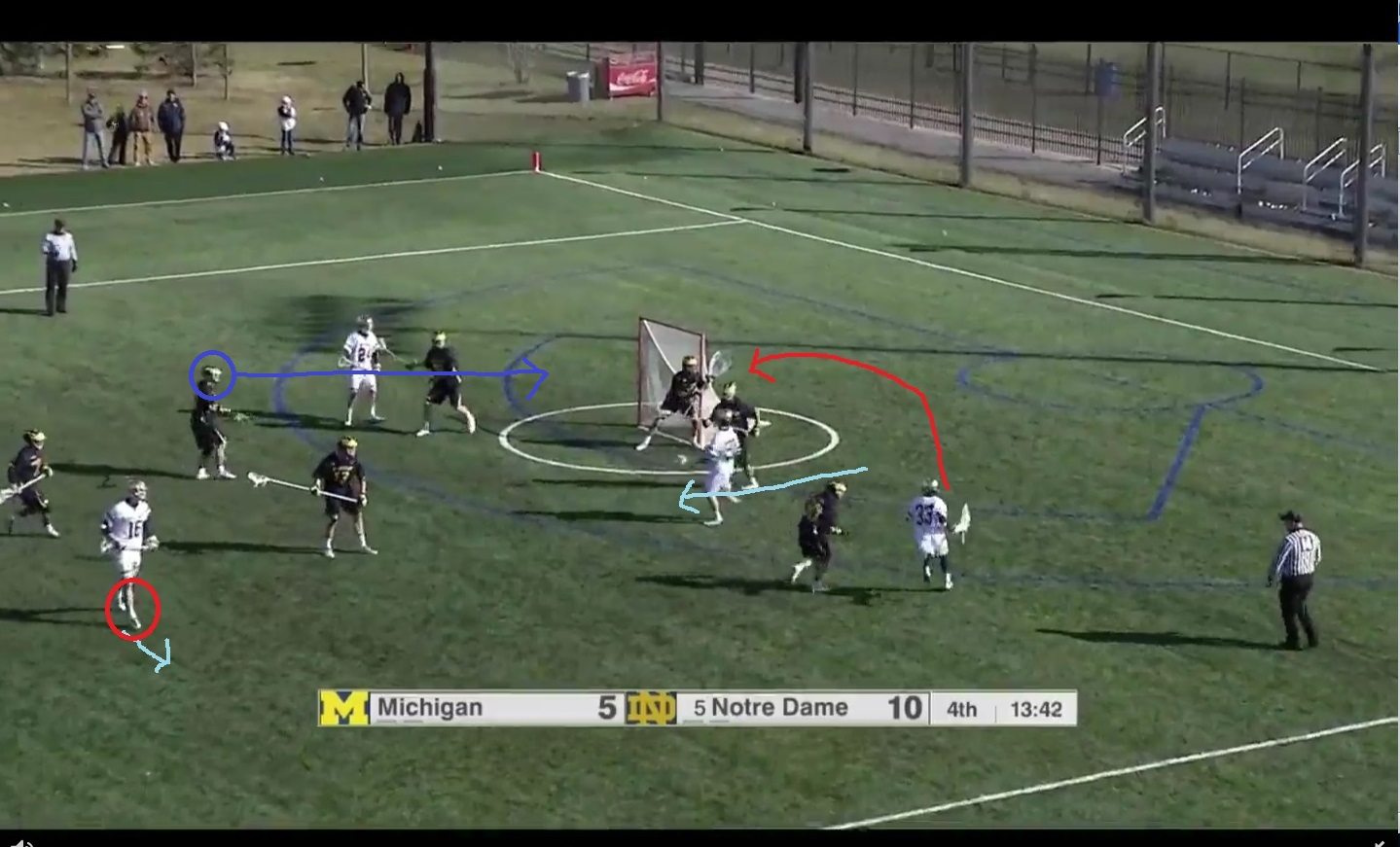
FIRST MOVES:
Garnsey’s defenseman is stuck on him like a remora, so moving him to the inside was quick and easy (defender had gotten burned by Ryder several times by this point). Perkovic quietly drifts into the open corner vacated by Byrne. Note: the defenders covering Garnsey, Wynne and Perkovic are focused on them entirely, they do not see the trap. One defender (blue circle) remains in a position to cut off Byrne coming around the cage and is looking intently on sliding to that spot. If the Irish can occupy him, the play will almost certainly be a success.
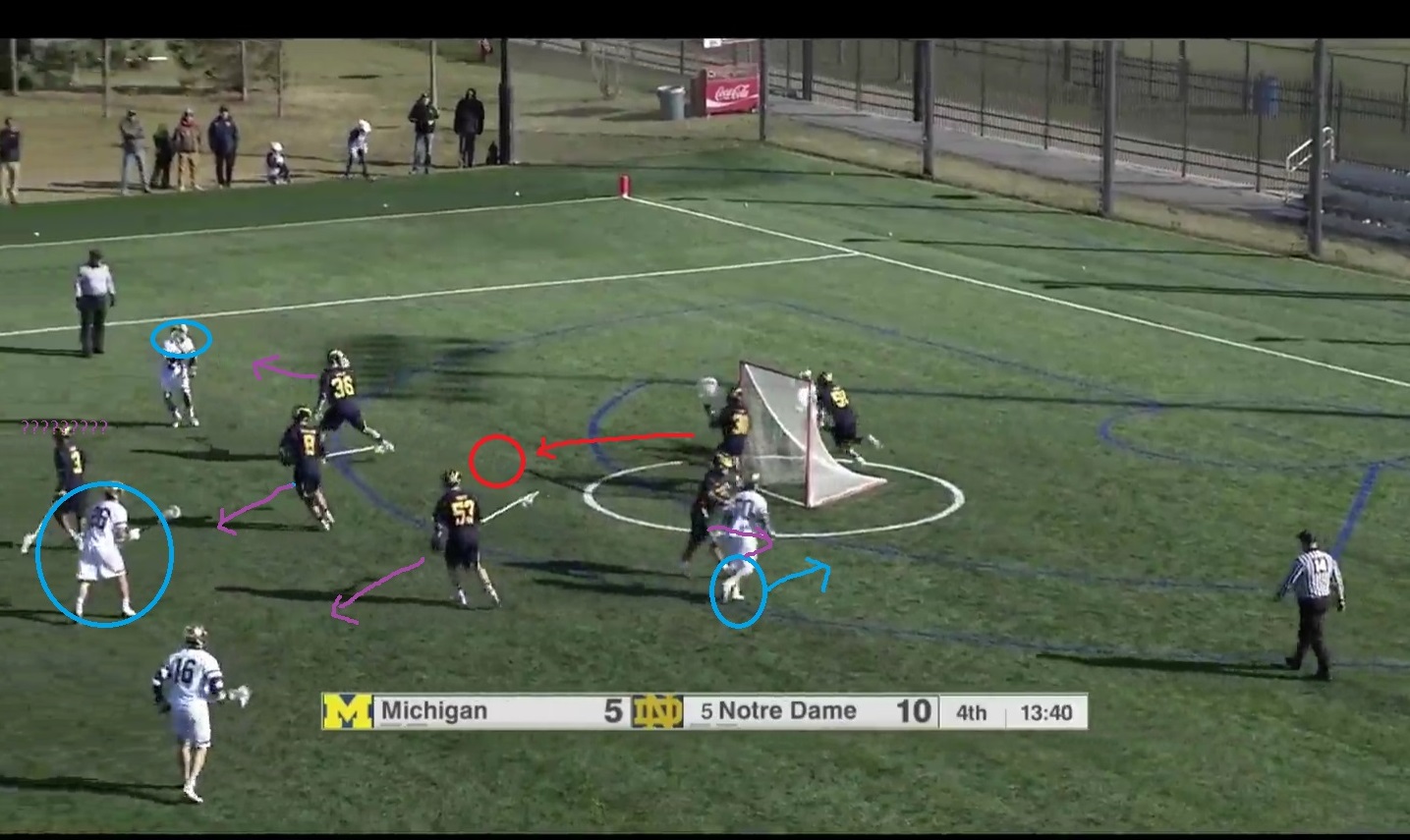
FINAL MOVES:
As soon as Byrne gets to the back of the goal, Garnsey immediately switches directions and begins dragging his defender out of the play. Perkovic inches forward and keeps the attention of his defender, while Wynne clears out. Note that Wynne is actively presenting his stick for a pass, forcing his defender to respect him. Finally, Costabile reappears into the play to take the attention of that last defender in a position to cut off Byrne. Note also that all four close defenders are hedging away from Byrne anticipating a pass. Gleason’s defender is simply daydreaming. As this point, a goal is a near certainty.
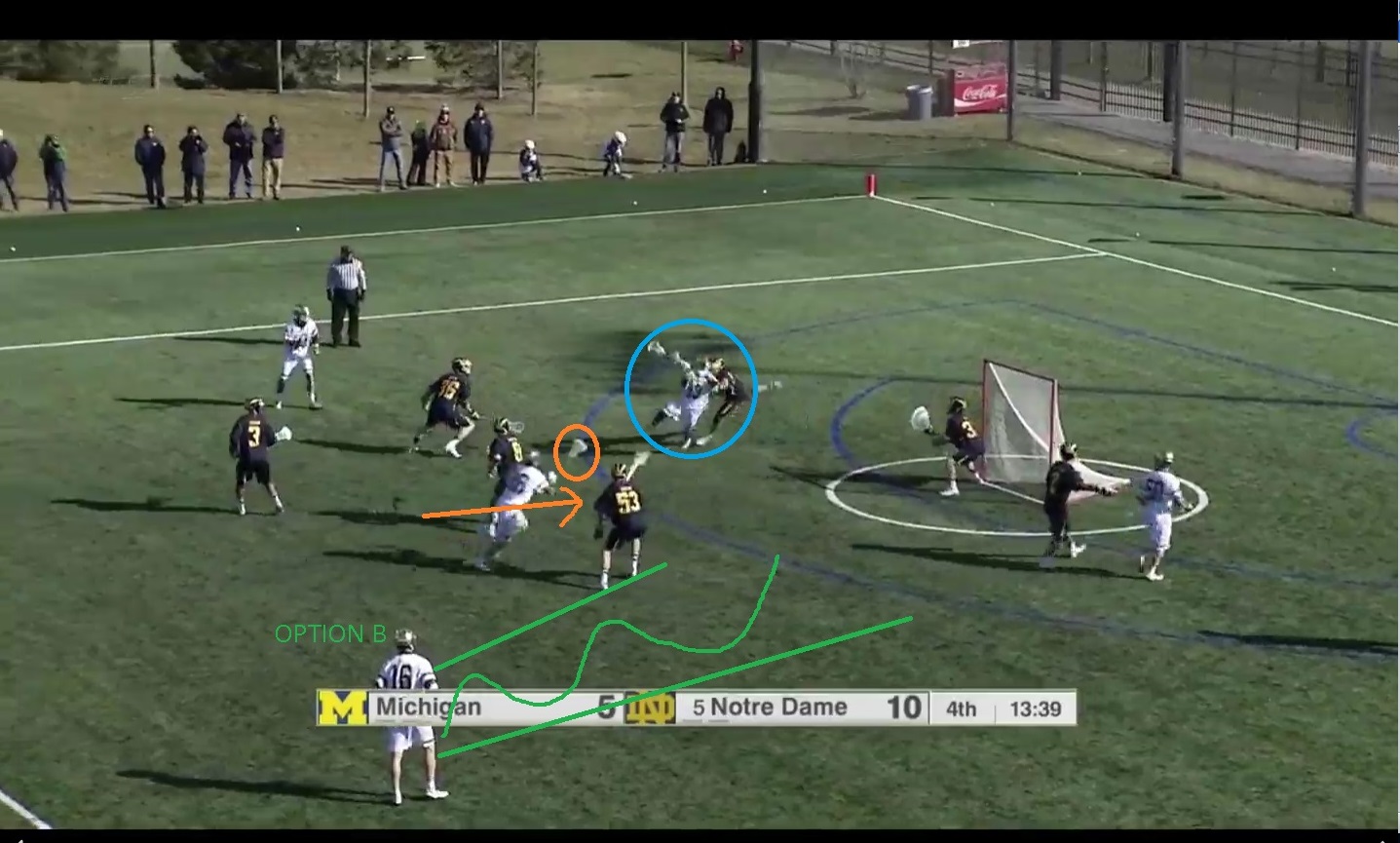
SCORE!
Byrne has completely beaten his guy and is shooting from the left 5×5, a near perfect position for a righty. Garnsey moved his defender, who has his back to the play anyway, far out of danger. Wynne moved his defender well out of a position where he could potentially slide to Byrne. Costabile now makes a break for the crease causing enough confusion to keep both defenseman near him from having any hope to cut off Byrne (In theory, had they not stayed to cover Costabile, Byrne would have an easy pass for a quick-stick goal). Note finally, Perkovic is WIDE open for an overhand blast had Byrne’s defender covered him better.
Byrne had a lot of options at the start of this sequence, but this particular one took advantage of precise movement by the Notre Dame offense and probably also looked to take advantage of the reputations of key players and what Michigan probably had in its scouting report. Garnsey’s defender was never going to give him room to breath near the crease, so he would have no problem moving him around. At least one defender will stay close to Perkovic to keep him from having time and room, and given his incredible range, this requires that defender to stay way to far out to be an effective slide option. Wynne is such an effective closer he has to be respected within 8 yards or so, plus he always presents as ready for the pass. Michigan probably identified Byrne as a pass-first player and did not give him enough respect as a dodger. As icing on the cake, Costabile cut in as soon as the defenders turned their backs in a classic move to cause complete chaos among the remaining defenders.
In short, the Irish made it impossible for Michigan to give Byrne’s defender any slide support. Since Byrne was covered by a short stick whom he cold likely beat with ease, this was a near perfect play.
For comparison, please also take a look at 18Stripes basketball writer NDRoyalsfan’s article on the 5 Out Offense. You will find similar spacing concepts at work in the successful ND hoops offense. Perkovic, Costabile, Gleason, Willets, etc. are not much different than the armada of 3-point shot threats holding a defense at the perimeter.
-Special thanks to 18Stripes writer Joe Schueller (twitter: @JoeSchuND) for his input on spacing concepts.
-If it comes up again during the Syracuse game this Saturday, we’ll consider another Lacrosse Playbook article evaluating the Casually-glance-over-to-Sergio offensive scheme that has embarrassed many opposing defenses this year.
Let us know in the comments what you think.



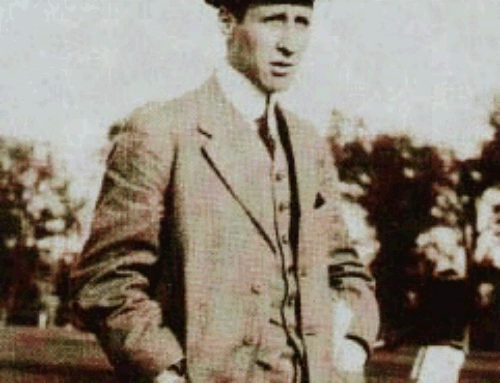
It was very hard to follow since I do not know any of the player’s names. I suggest marking them somehow. I gave up.
Thanks for the feedback, we often forget these are not household names to most!
If you have any interest, remember #16 Perkovic and #50 Garnsey to start. You will hear a lot about those two in any broadcast, with the rest of the season schedule on ESPNU. Watching them.is fun even if you know nothing about lacrosse.
I scrolled up and down and worked my way along…
I usually skip lacrosse articles along with the miscellany sports but any beatdown of Muck is a must read. Thus scrolling aside, I found it to be an enjoyable read of a fantastic offense at work. I am now looking forward to reading more. Thanks!
Thanks for the comment. We hope to make these more relatable to folks not as familiar with lacrosse. It’s a work in progress. If you are interested in Irish lacrosse, as noted above ND will be on ESPNU every weekend through (and hopefully including) memorial day. The lacrosse broadcasts are excellent and they do a lot to make it entertaining for new fans.
I’ve been lucky enough to be involved with basketball and teaching offensive concepts for a long time. I’ve also had the benefit of a cup of coffee doing some youth lax coaching. Neither have been on the scale of big-time NCAA operations, but the game(s) are still the game(s), and when ND-Atl invited me to work with him on this, I jumped at the chance.
The play he’s demonstrating here does share a lot in concept with some of the basketball movement that Brey uses. The primary coaching point in common is spacing. By maintaining healthy spacing, both lax and basketball offenses stress the opponent’s defense. Most defenses are designed to provide multiple layers of help by hedging and switching (sliding in lax). By extending the distance a defender needs to cover between their man and their help responsibility, the offense can exploit 1v1 advantages, as Bryne does here.
For those of you who like these technical differences and (like me) enjoy both sports, what fascinates me is the value of the baseline and corner. In lax, GLE isn’t a valuable offensive position, other than to set up scoring opportunities. In basketball (particularly the NBA), the corner 3 has become one of the most valuable shots in the game. In modern basketball offenses, when a player beats his man on the drive (dodge in lax), his teammate on the weak side is coached to “drift” to the opposite baseline (GLE), as a reliable kick-out for the corner 3. Given that most defenses hedge towards the ball, that weak side defender will struggle to locate the corner shooter and recover to challenge the shot. Make a few corner 3’s and suddenly help rotates (slides) much less aggressively.
Fun exploration. Love the film breakdown and discussion!
Thanks, Joe-
For us, we look at the lacrosse and basketball plays being nearly the exact same thing but rotated 45 to 90 degrees or so. One must consider that an essential difference between hoops and lacrosse is the baseline as a boundary in basketball. In lacrosse there is a lot of room to maneuver back there, way more than even hockey. In basketball it can act as an extra defender against a driving ball carrier, whereas a lacrosse dodger can wander behind the goal (“X”) and reengage the attack from a reverse angle. This changes the geometry of the play.
The lacrosse dodger then coming from X to the front of the goal will have similar obstacles to a driving basketball player because now he should be dodging into a bigger crowd. The outlet to the “corner three” for the lacrosse player is in the same spot, it’s just that the field has been rotated 90 degrees since the lacrosse player is coming from a back corner instead of in front of the hoop. Consider the play above, the final geometry of Byrne’s dodge is from the back left corner. Perkovic (although in the top right in lacrosse) is in the same general position a corner 3-point shooter would be, give or take a few degrees.